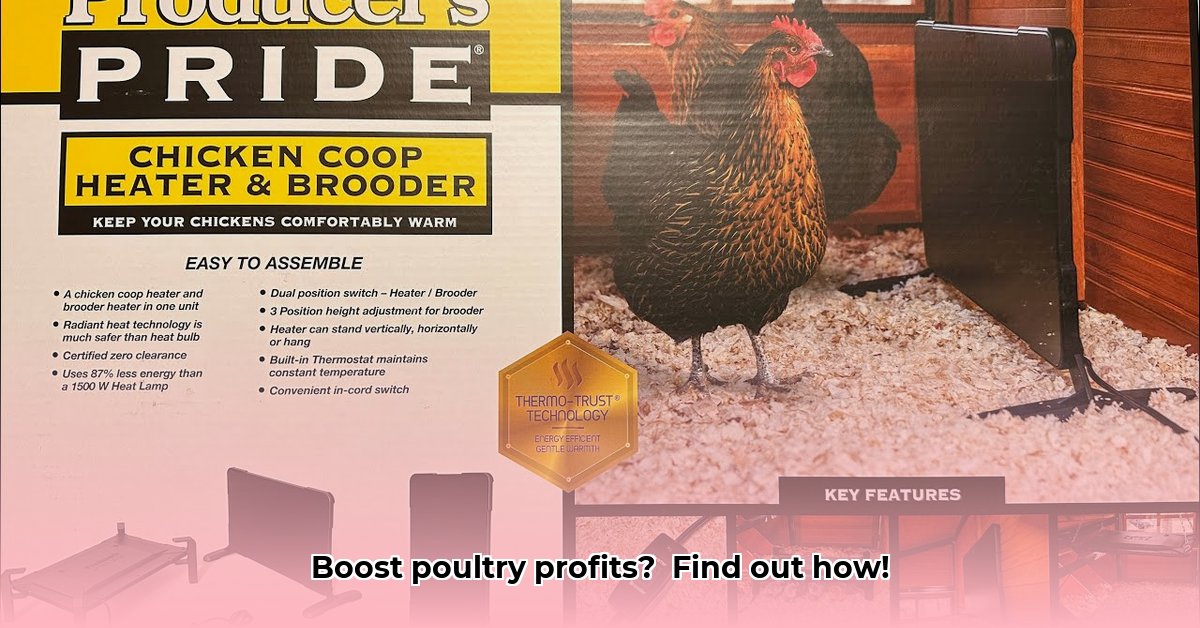
Chicken Heater Tractor Supply: Keeping Your Flock Warm and Profitable
Winter's chill presents significant challenges to poultry farmers. Cold temperatures lead to decreased egg production, increased illness, and ultimately, reduced profitability. A chicken heater from Tractor Supply (or a comparable retailer) offers a practical solution to mitigate these winter woes. This guide helps you select and safely utilize a heater to ensure healthy, productive chickens throughout the winter months. For more information on chicken heaters from Tractor Supply, check out this helpful resource.
Understanding the Importance of Chicken Heaters
Maintaining optimal temperatures is crucial for chicken health and productivity. When temperatures plummet, chickens expend more energy to maintain their body temperature, leading to stress. This stress manifests as reduced egg laying, weakened immune systems (increasing disease susceptibility), and even frostbite in extreme cases. Furthermore, frozen water poses a serious threat; dehydration rapidly leads to health problems. A well-chosen chicken heater helps prevent these issues, protecting your investment and maximizing your profits. Did you know that even a slight drop in temperature can result in a measurable decrease in egg production?
Selecting the Right Chicken Heater
Choosing the appropriate heater depends on several factors: coop size, climate, and budget. Tractor Supply offers various options, each with advantages and disadvantages.
| Heater Type | Pros | Cons | Best For | Considerations |
|---|---|---|---|---|
| Ceramic Heat Emitter | Energy-efficient, longer lifespan, generally safer than incandescent lamps | Higher initial cost than some other options | Larger coops, consistent cold weather | Look for models with automatic shut-off features to minimize fire risk. |
| Hanging Heat Lamps | Relatively inexpensive, widely available | Significant energy use, shorter lifespan, potential fire hazard if not used properly | Smaller coops, supplemental warmth, temporary solutions | Always use a protective cage around the lamp to prevent accidental contact and fires. |
| Radiant Heat Panels | Even heat distribution, energy efficient, can be thermostatically controlled | Typically the most expensive upfront option | Larger coops, precise temperature control, more even heat distribution | Consider the cost and benefits; may be worth the investment for larger flocks or harsh climates. |
Always verify wattage and coverage to ensure suitability for your coop's dimensions. Prioritize safety features; automatic shutoff is crucial for fire prevention. According to Dr. Emily Carter, Poultry Science Professor at [University Name], "Investing in safety features is not an added expense—it's an insurance policy against potential losses."
Safe Heater Installation and Usage
Proper installation is paramount for both heater efficacy and chicken safety. Follow these steps:
Placement: Position the heater away from flammable materials (bedding, wood). Ensure adequate ventilation. Ideally, place it higher to minimize burn risks.
Secure Mounting: Securely mount according to manufacturer instructions. Use sturdy chains/hooks for hanging heaters.
Wiring and Grounding: Use appropriately sized wiring and ensure proper grounding to prevent shocks. A GFCI outlet is highly recommended.
Temperature Monitoring: Use a reliable coop thermometer. Monitor and adjust the heater to maintain the ideal temperature (generally 45-55°F, but this varies by breed and age).
Protective Measures: Use a protective cage to prevent pecking and damage––this is critical for the safety of your birds and for fire prevention.
Regular Inspection: Regularly inspect for damage and replace worn parts immediately.
Comprehensive Winter Chicken Care
A heater is only one aspect of winter poultry management. These additional measures ensure flock health:
Coop Insulation: Insulate your coop to minimize heat loss. Seal drafts.
Deep Bedding: Use deep (6-8 inches) bedding for added insulation.
Water Management: Prevent water freezing. Consider heated waterers or bringing water inside during freezing temperatures.
Regular Monitoring: Regularly monitor your flock for illness.
Investing in a heater and implementing these strategies is a crucial investment in your flock's health and your profitability. While these practices reduce risks, some mortality is always possible. Breed-specific recommendations should inform your winter care plan.
How to Choose the Best Poultry Watering System for Sustainable Farming
Key Takeaways:
- Automatic waterers significantly reduce labor.
- System choice depends on flock size and climate.
- Material selection impacts durability and longevity.
- Regular cleaning and maintenance are vital for hygiene and efficiency.
Assessing Your Needs: Flock Size and Climate
Before selecting a watering system, evaluate your flock size and climate. A small backyard flock requires a different system than a large-scale commercial operation. Climatic factors (freezing temperatures) necessitate systems capable of withstanding freezing conditions, potentially requiring insulation or heating.
Available Poultry Watering Systems
Several systems exist, each with pros and cons:
- Gravity-fed: Simple, inexpensive, ideal for small flocks, requires frequent refilling.
- Nipple drinkers: Prevent spillage and contamination; suitable for larger flocks, higher initial investment.
- Bell drinkers: Relatively inexpensive and easy to clean, prone to spillage and freezing.
- Trough systems: Suitable for larger flocks, require close monitoring to prevent contamination and maintain adequate water levels.
Material Considerations: Plastic vs. Metal
Material choice significantly impacts durability and longevity.
| Material | Pros | Cons |
|---|---|---|
| Plastic | Lightweight, inexpensive, easy to clean | Can degrade in sunlight, prone to freezing |
| Metal | Durable, resists freezing, long-lasting | Heavier, can rust, more expensive |
Sustainable System Features
Several features enhance sustainability:
- Easy Cleaning: Facilitates disease prevention.
- Leak Prevention: Minimizes water waste.
- Algae Prevention: Shading reduces algae growth.
- Durability: Reduces waste and long-term costs.
Installation and Maintenance
Proper installation is crucial. Follow manufacturer instructions meticulously. Regular cleaning and maintenance are essential for hygiene and system longevity. This includes refilling, sanitizing, and leak checks. These practices maximize the lifespan of your investment and contribute to a sustainable poultry operation. According to John Miller, a leading expert in sustainable agriculture at [Institution Name], "A well-maintained watering system directly impacts both the health of your flock and the sustainability of your farm." 1